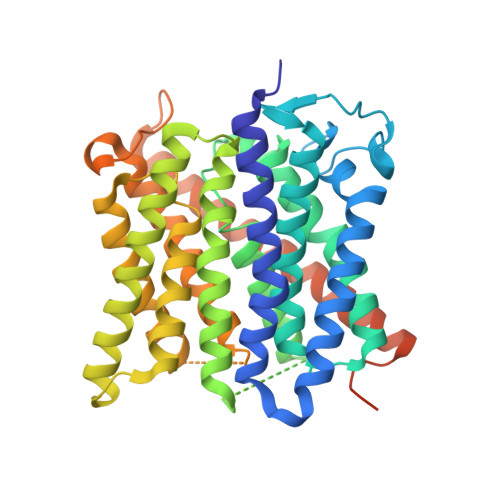The mechanism of ammonia transport based on the crystal structure of AmtB of Escherichia coli
Zheng, L., Kostrewa, D., Berneche, S., Winkler, F.K., Li, X.-D.(2004) Proc Natl Acad Sci U S A 101: 17090-17095
- PubMed: 15563598
- DOI: https://doi.org/10.1073/pnas.0406475101
- Primary Citation of Related Structures:
1XQE, 1XQF - PubMed Abstract:
Ammonium is one of the most important nitrogen sources for bacteria, fungi, and plants, but it is toxic to animals. The ammonium transport proteins (methylamine permeases/ammonium transporters/rhesus) are present in all domains of life; however, functional studies with members of this family have yielded controversial results with respect to the chemical identity (NH(4)(+) or NH(3)) of the transported species. We have solved the structure of wild-type AmtB from Escherichia coli in two crystal forms at 1.8- and 2.1-A resolution, respectively. Substrate transport occurs through a narrow mainly hydrophobic pore located at the center of each monomer of the trimeric AmtB. At the periplasmic entry, a binding site for NH(4)(+) is observed. Two phenylalanine side chains (F107 and F215) block access into the pore from the periplasmic side. Further into the pore, the side chains of two highly conserved histidine residues (H168 and H318) bridged by a H-bond lie adjacent, with their edges pointing into the cavity. These histidine residues may facilitate the deprotonation of an ammonium ion entering the pore. Adiabatic free energy calculations support the hypothesis that an electrostatic barrier between H168 and H318 hinders the permeation of cations but not that of the uncharged NH(3.) The structural data and energetic considerations strongly indicate that the methylamine permeases/ammonium transporters/rhesus proteins are ammonia gas channels. Interestingly, at the cytoplasmic exit of the pore, two different conformational states are observed that might be related to the inactivation mechanism by its regulatory partner.
Organizational Affiliation:
Biomolecular Research, Paul Scherrer Institut, CH-5232, Villigen, Switzerland.
















